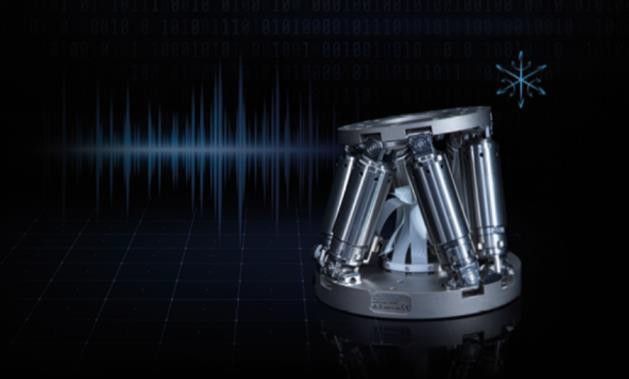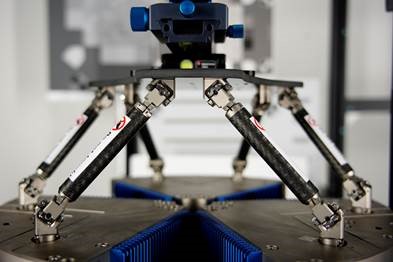Taking sharp pictures despite fast changing lighting and ambient conditions, recognizing traffic signs or road markings in driver assistance systems, or identifying dangerous situations in surveillance systems – all of this is possible today with the help of modern cameras.
 Improving Image Stabilization with Hexapod 6-Axis Motion Simulators for More Reliable Image Capturing
Improving Image Stabilization with Hexapod 6-Axis Motion Simulators for More Reliable Image Capturing

Doris Knauer, Project Manager Global Campaigns Industrial Automation | Physik Instrumente (PI) GmbH
End users, manufacturers of smartphones and cameras, companies in the automobile and aerospace industries, companies in the security or automation technology sectors – they all place high demands on the quality of still and video images. As a consequence, cameras are being evaluated in comprehensive tests on the basis of specific image attributes. These attributes include resolution, contrast, color, texture, zoom, autofocus, exposure and image stabilization. For each of these attributes, thousands of images are taken and evaluated to obtain statistically significant results. In order for the image quality to be comparable, cameras and camera components must always be tested under the same conditions and using the same methods.
.jpg)
Image 1a: Image stabilization algorithms and technologies need repeatable test conditions to be comparable and allow for faster progress. Hexapods are used to simulate unwanted camera vibration and motion in X, Y, Z, pitch, yaw and roll during image recording. (PI)
.jpg)
Figure 1b: Driver assistance systems are among the beneficiaries of reliable, high quality images under all kinds of conditions including vibration and unpredicted motion in many degrees of freedom. (PI)
Reliable Analytical Methods
DXOMARK (headquartered in Boulogne, France) specializes in complete laboratory solutions for the analysis, the comparison, and the optimization of image quality. The Analyzer systems (Figure 2) consist of hardware, software, and extensive testing protocols, bundled within serval modules that ensure repeatable, operator-independent results.
Depending on the task at hand or on the image quality attributes being evaluated, different modules can be used and combined. A special capability of Analyzer is the visual noise measurement. It produces visual noise metrics, which directly correlate with visual perception. The video analysis encompasses exposure, white balance, definition, and texture for changing lighting conditions. Automated lighting scenarios can also be programmed for user-specific test requirements. The latest version of Analyzer includes the Selfie module to enable accurate and repeatable smartphone front-camera testing.

Figure 2: The new Analyzer is a high-performance and very reliable solution for the measurement of still and video image quality and can be applied in different business sectors. (DXOMARK)
The measurement methods on which the DXOMARK evaluation is based, have been developed in collaboration with several companies in the imaging industry that collaborate in international standardization working groups such as IEEE/CPIQ and ISO TC42-WG18.
Testing Image Stabilization
The image stabilization test assesses how well the optical and electronic image stabilization systems built into cameras work. These systems are designed to compensate movements and, therefore, avoid blurred images. In order to guarantee stable image capturing, sensors measure linear and angular motion accelerations, for example, the photographer's shaky hands holding the camera or the vibrations of vehicles and aircrafts so that the image stabilization system can automatically offset these influences and avoid blurred images. The effectiveness of image stabilization systems, whether optical or electronic, therefore, follows the CIPA protocol. CIPA (Camera and Imaging Product Association) is an alliance of Japanese camera manufacturers that has developed standards for defining the test conditions for motion simulation.
Motion Simulation with High Repeatability
For all image stabilization test methods, it is important that the shaking camera or the vibrations in vehicles and aircrafts are reproducible.
"We must ensure that the simulated frequencies and movements, for example, around the rotation axes θX, θY, θZ (pitch, yaw, roll), are identical for each test," emphasized Nicolas Touchard, Vice President of Marketing at DXOMARK. "We are currently using hexapods in the latest version of Analyzer because they allow precisely reproducible motions up to frequencies of 30 Hz, increasing the number of potential test scenarios. We have to ensure that the simulated motion remains unchanged for all tests. Hexapods are very well suited to perform this task."
Camera and smartphone tests typically require up to 12 Hz, however, the image stabilization function of driver assistance systems offset much higher frequencies. Thanks to their parallel-kinematic design, hexapods are virtually predestined for several reasons for the precise simulation of motions and vibrations. Their advantages compared with serial (stacked) systems, are, that they have much better path accuracy, repeatability and flatness. In addition, the moved mass is lower, enabling better dynamic performance, which is the same for all motion axes. Also, cable management is no longer an issue, because cables are not moved, and the system has a much more compact design.
Suitable Specifications and Qualified Support
The hexapods used in the latest Analyzer version are from the German company PI (Physik Instrumente). The H-840 hexapod, for example, is designed for the testing of image stabilization systems and certified to CIPA Standard DC-011-2015. This standard defines rotational axes, test frequencies, and vibration amplitudes that are necessary for certification.
Since mid-2019, another hexapod is being used by the Analyzer (Figure 4). The H-860 hexapod is designed for the testing of image stabilization systems. It offers simulation frequencies up to 30 Hz, and travels predefined trajectories (sinusoids) and freely definable paths with a high degree of trajectory control. Due to the friction-free voice coil drives and the lightweight design consisting of extremely stiff carbon fiber parts with low-moving masses, it is possible to achieve fast and smooth motion as well as high acceleration.

The hexapod used for testing is fixed to a base plate. The brackets for the test items are installed on the base plate. They keep the test device safely in place on the hexapod during vibration simulation.
"We have not only decided in favor of these hexapods because they have the perfect specifications for vibration simulation but also because PI provides support, for example, for the adaptation of the software drivers", Touchard adds.
Easy Control and a Freely Definable Pivot Point
The high-performance C-887 digital controller (Figure 5) takes care of the control for the hexapods, and the software enables easy commanding. Positions are specified in Cartesian coordinates and transformations for the six individual drives takes place in the controller. The freely definable rotation or pivot point is an essential feature of the hexapod. This means that the motion of the hexapod platform can be specifically adapted to the position of the image stabilization component in the camera so that, for example, the image sensor is located in the middle of all six degrees of freedom.

Figure 4: Digital hexapod controller for easy control. (PI)
By now, hexapods have proven their worth for image stabilization testing. The six-axis parallel kinematics also provide advantages in other applications and are at the forefront of the race for many motion simulations, like in mechanical engineering and drive technology, tests for multi-dimensional position sensors, as well as the calibration of gyroscopic compasses pursuant to DIN ISO 22090-1 for shipping and marine technology.
About DXOMARK
DXOMARK is headquartered in Boulogne near Paris, and has been supporting its customers for over a decade with testing and improving the image quality and performance of their stand-alone and mobile device cameras. The company offers solutions and services for all sectors of the digital imaging industry, from DSLR and DSC manufacturers to smartphone and camera component producers, and video-based driver assistance systems in the automotive industry, to companies in the surveillance, aerospace, defense, and machine vision space.
About Physik Instrumente L.P.
Physik Instrumente L.P. (PI) is a leading manufacturer of nanopositioning, linear actuators and precision motion-control equipment for photonics, nanotechnology, semiconductor and life science applications. PI has been developing and manufacturing standard and custom precision products with piezoelectric and electromagnetic drives for over 50 years. The company has been ISO 9001 certified since 1994, and with more than 350 granted and pending patents, it provides innovative, high-quality solutions for OEM and research. PI has a worldwide presence with 10 subsidiaries and over 1,300 staff.
The content & opinions in this article are the author’s and do not necessarily represent the views of RoboticsTomorrow

PI USA (Physik Instrumente)
PI is a privately held company that designs and manufactures world-class precision motion and automation systems including air bearings, hexapods and piezo drives at locations in North America, Europe, and Asia. The company was founded 5 decades ago and today employs more than 1700 people worldwide. PI's customers are leaders in high-tech industries and research institutes in fields such as photonics, life-sciences, semiconductors and aerospace.
Other Articles
High-Throughput PIC Production Needs Precision Alignment Equipment for Photonics Arrays, Fibers, Lenses
Fast Hexapod Improves Aircraft Manufacturing Process
Fiber Alignment and Photonic Chip Test & Assembly Just Got Easier
More about PI USA (Physik Instrumente)
Comments (0)
This post does not have any comments. Be the first to leave a comment below.
Featured Product

